What follows is a series of yoga poses that predominantly target the piriformis, helping to relieve sciatic pain:
|
| |
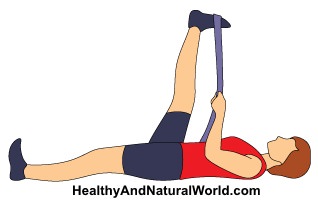 1. Reclining Big-Toe Pose
Beginner's Tip:
To make this pose slightly easier, raise the lower-leg heel off the
floor by a few inches, or place it on a foam block or thick book for
extra comfort and support. You may also use an elastic strap, placing it
around the ball of your foot. Place a folded blanket under your head
for added comfort. 1. Reclining Big-Toe Pose
Beginner's Tip:
To make this pose slightly easier, raise the lower-leg heel off the
floor by a few inches, or place it on a foam block or thick book for
extra comfort and support. You may also use an elastic strap, placing it
around the ball of your foot. Place a folded blanket under your head
for added comfort.
Here's How:
1. Lie on the floor, keep
your legs strongly extended with your feet flexed. Exhale and bend the
right knee, drawing your thigh to your torso, hugging it to your belly.
Keep your left leg extended, pushing actively through the heel.
2. Loop a strap around the
arch of the right foot, holding the strap with both hands. On your next
inhalation, extend the knee straight, pressing your heel up toward the
ceiling. Reach your hands as far up the strap as possible, until your
elbows are extended.
3. Keep your shoulder blades
broad across the back, pressing lightly into the floor. Keep your
collarbones wide, reaching away from the sternum. Your sitting bones
should be firmly planted on the floor.
4. Hold the pose for 10 deep
breaths. Then lower the leg slowly by bending the knee towards your
chest and slowly releasing it to the floor. Repeat on the left side.
|
| |
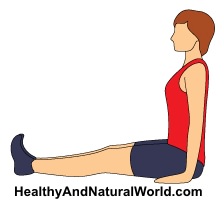 2. Staff Pose 2. Staff Pose
Beginner's Tip: This
is a basic seated pose, which aside from relieving sciatica, will also
help improve posture. Lay a 10-pound sandbag across the top of your
thighs at the hip crease to help keep your thighs grounded. You may also
practice this pose by keeping your back against the wall.
Here's How:
1. Sit on the floor,
extending both legs in front of you. Keep your legs together and your
torso upright. If your torso is leaning back, sit up on a blanket or
cushion to help lift your pelvis. If practicing against a wall, your
sacrum and shoulder blades should touch the wall, but not the lower back
or the back of the head.
2. Sit on the front parts of
your sitting bones, keep your thighs firm, pressing them down against
the floor, rotating them slightly toward each other. Keep your ankles
flexed, pressing out through your heels. Keep your spine long, as if
you're being pulled by a string from the crown of your head. Hold for
one minute taking long, deep breaths.
|
| |
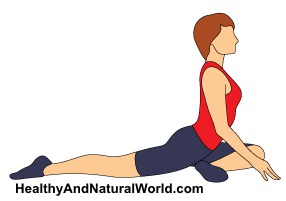 3. Pigeon Pose 3. Pigeon Pose
Beginner's Tip: This pose stretches the piriformis. Place a thick, folded blanket underneath you hip for extra support.
Here's How:
1. Start on all fours. Bring
the right knee forward and out between your hands. Slowly sink your hips
to the floor. As you do so, release your left leg onto the floor behind
you, slowly sliding it back while bringing your body forward. Keep your
left toes pressed down on the mat.
2. Your right heel should be
in line with your left hip and your shin should be at about a 45 degree
angle. If you feel yourself tilting over to the right hip, place a
blanket underneath for extra support. Keep your hips parallel to the
front of your mat as much as possible. Use your fingertips to support
your torso and keep your spine long, shoulder blades drawing close
together. Hold for 10 deep breaths and repeat on the other leg.
|
| |
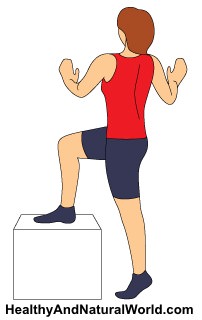 4. Standing Twist 4. Standing Twist
Beginner's Tip:
To reap the benefits of this pose, place a chair against the wall,
using both the chair and the wall for extra support, enabling you to
twist deeper.
Here's How:
1. Stand with your right hip
against the wall with your body facing the chair. Put your right foot up
on the chair, keeping your knee bent. Also keep it in line with your
ankle. Your standing leg should be straight. Press your right hand
against the wall, to help you balance.
2. Slowly lift your left heel
up and turn your torso towards the wall, supporting your hands with the
wall for extra support. Exhale and lower your heel to the floor,
staying in the twist for a couple more breaths. Slowly return to the
starting position, repeating on your left side.
|
| |
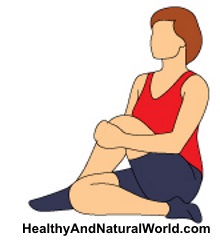 5. Preparation for Spinal Twist 5. Preparation for Spinal Twist
Beginner's Tip: Sit on the corner of a folded blanket for extra support in the full seated spinal twist pose (see below).
Here's How:
1. Sit with your knees bent
and your feet out in front of you. Release your right leg on the floor,
taking your right heel to the outside of your right hip. Then bring your
left foot around, placing your left heel by your right hip. Your weight
should be evenly distributed across your buttocks.
2. Interlock your fingers
over your left knee, while focusing on lengthening your spine. Hold this
position for several breaths. Then proceed onto the next pose. |
. Simple, Seated Twist
Here's How:
1. From the preparation pose
described above, turn your torso (from your waist, not your hip) toward
the left knee. Place your left hand behind you, using it as a lever to
twist (your weight should not be supported by your left arm). Hold onto
your knee with your right hand.
2. It is vital that you do
not go too deeply into the twist, as doing so will worsen piriformis
syndrome. Repeat on the opposite side, starting with the pose above.
|
| |
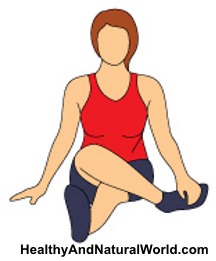 7. Cow's Face Pose 7. Cow's Face Pose
Beginner's Tip: For
extra support in this passive stretch, sit on a blanket. If in the pose
you notice that your left leg is not touching the floor, or the left
knee locks or hurts during the stretch, roll up a second blanket or
towel and place it under your knee.
Here's How:
From staff pose (number 2),
bend your right knee, bringing your right leg across the left leg. Bring
your right foot close to your outer left hip.
Move your left leg towards
the mid-line - it should be slightly diagonal to your body. Your right
hand should be on the floor while your left hand holds your right foot.
Keep your spine extended, holding the position for a couple of breaths,
then repeat on the other side. |
|

 2. Staff Pose
2. Staff Pose 3. Pigeon Pose
3. Pigeon Pose 4. Standing Twist
4. Standing Twist 5. Preparation for Spinal Twist
5. Preparation for Spinal Twist 7. Cow's Face Pose
7. Cow's Face Pose
0 Comments:
Post a Comment
<< Home